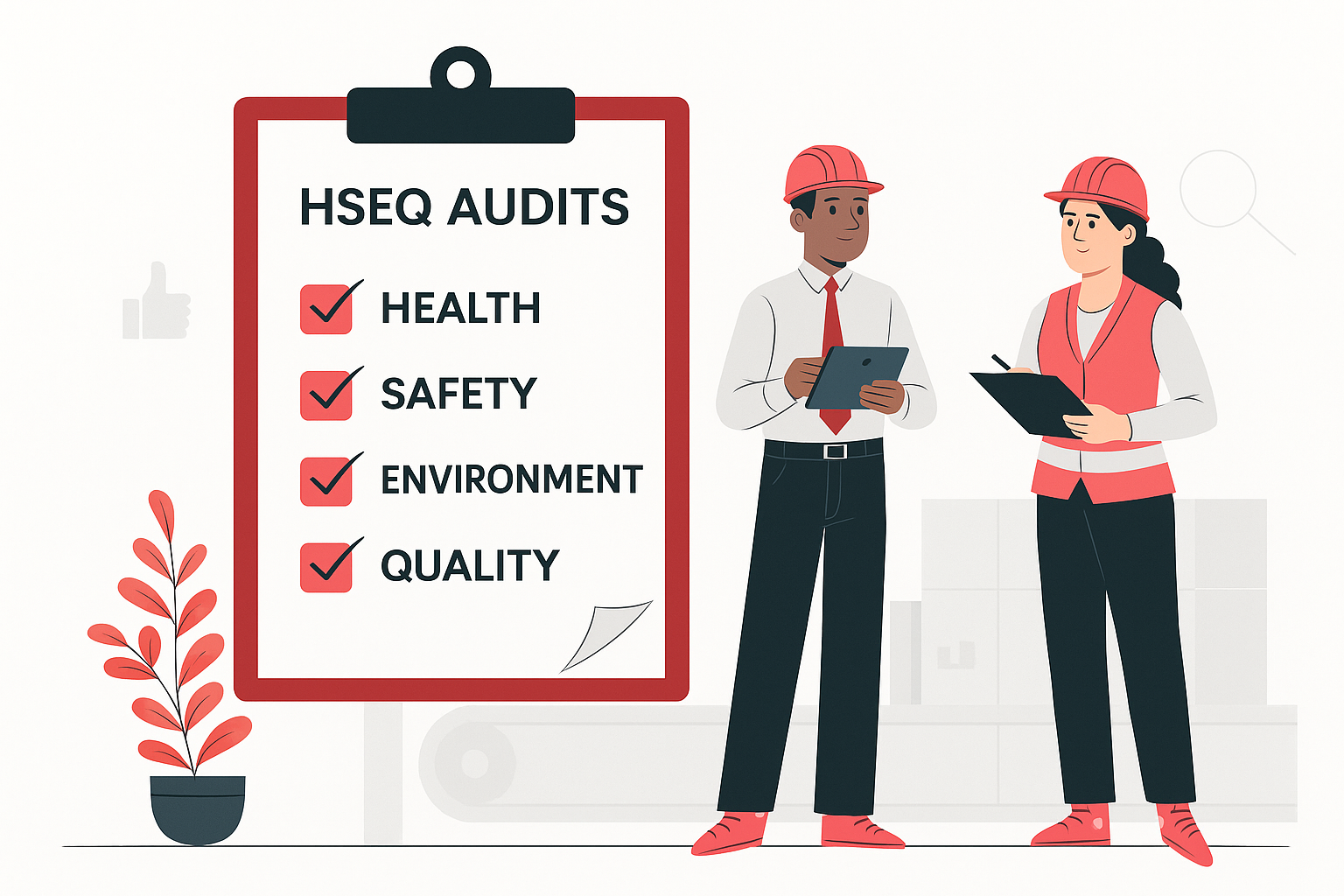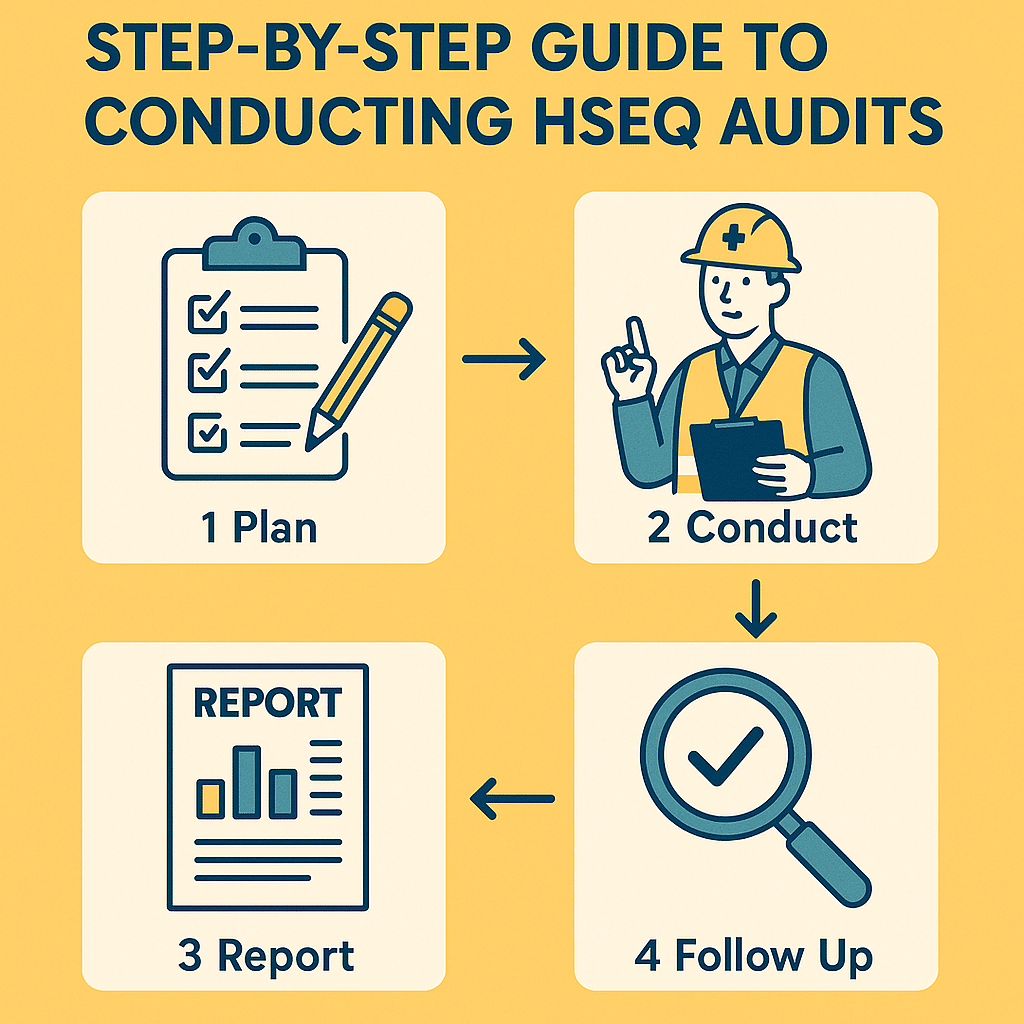HSEQ Audits are powerful tools that allow businesses to assess compliance, identify risks, and improve performance across Health, Safety, Environment, and Quality domains.

Whether you operate a manufacturing plant, run a logistics company, or manage a construction project, HSEQ audits ensure that your operations align with legal standards and best practices.
This step-by-step guide explains how to conduct efficient and impactful HSEQ audits that lead to measurable improvements in your workplace.
What Is an HSEQ Audit?
An HSEQ Audit is a systematic review of an organization’s health, safety, environmental, and quality management systems. The goal is to verify that operations:
- Meet internal policies and external regulations
- Identify areas of risk or non-compliance
- Promote continual improvement and operational excellence
HSEQ audits are often aligned with ISO standards such as:
- ISO 45001 – Occupational Health and Safety
- ISO 14001 – Environmental Management
- ISO 9001 – Quality Management
Benefits of Conducting HSEQ Audits
- Identify and control risks before incidents occur
- Ensure regulatory compliance to avoid penalties
- Improve system efficiency and resource allocation
- Build a culture of accountability and transparency
- Drive continual improvement across all HSEQ pillars
Step-by-Step Guide to Conducting HSEQ Audits
Step 1: Define the Audit Objectives and Scope
Start by outlining the goals of your audit:
- Are you checking ISO compliance?
- Are you preparing for a certification?
- Is the audit focused on one site, department, or system?
Clearly define the scope—e.g., environmental practices in a warehouse or quality control in a production line.
Step 2: Develop an HSEQ Audit Plan
A detailed audit plan includes:
- Timeline and duration
- Audit criteria (e.g., legal standards, internal procedures, ISO clauses)
- Checklist or templates
- Team assignments and responsibilities
Use standardized tools like ISO audit checklists or digital platforms such as iAuditor or EcoOnline.
Step 3: Assemble and Train the Audit Team
Choose auditors who are:
- Competent and objective
- Familiar with HSEQ principles
- Trained in audit methodology (internal or third-party)
Provide refresher training on interview techniques, document review, and evidence gathering.
Step 4: Conduct the Opening Meeting
Start the audit with an opening meeting involving key personnel:
- Explain the audit purpose and plan
- Review health and safety protocols
- Confirm access to documentation and personnel
This ensures everyone is aligned and prepared.
Step 5: Collect and Verify Evidence
Use multiple methods to gather information:
- Interviews with staff and supervisors
- Site inspections and observations
- Document reviews (e.g., risk assessments, training records, permits)
- Review of KPI data (e.g., LTIFR, emissions, product defect rates)
All findings must be evidence-based and traceable.
Step 6: Identify Non-Conformities and Opportunities for Improvement
Classify audit findings into:
- Conformities (compliance with criteria)
- Minor non-conformities (process inconsistencies without major risk)
- Major non-conformities (legal or procedural violations)
- Opportunities for improvement (best practice suggestions)
Each non-conformity should include:
- Clear description
- Reference to the standard or procedure
- Supporting evidence
- Suggested corrective action
Step 7: Conduct the Closing Meeting
Summarize:
- What went well
- Key issues found
- Next steps for corrective actions
- Timelines for response
Use this meeting to align expectations and encourage ownership from department leads.
Step 8: Prepare and Distribute the Audit Report
A good HSEQ audit report includes:
- Executive summary
- Scope and objectives
- Methodology used
- Detailed findings
- Corrective action plan
- Follow-up deadlines
Distribute it to management, safety officers, and department heads. Save it in your HSEQ system for traceability.
Step 9: Track Corrective Actions and Verify Closure
Corrective actions must be:
- Assigned to responsible individuals
- Monitored with deadlines
- Verified for effectiveness
Use a Corrective Action Register or audit tracking tool. Re-audit high-risk findings if needed.
Step 10: Review and Improve the Audit Process
Conduct a post-audit review:
- Did the audit achieve its goals?
- Were timelines met?
- Were findings resolved?
- Was there sufficient engagement?
Use this feedback to improve your next audit cycle.
Tools to Support HSEQ Audits
- iAuditor by SafetyCulture – digital checklists and mobile audit tools
- ETQ Reliance – enterprise QMS and audit management
- EcoOnline – environmental and chemical compliance
- Excel/Google Sheets – for manual tracking and scoring
- OHSE.ca Templates – free Canadian audit tools and guides
Internal & External Links
- See our full guide on HSEQ Metrics – OHSE.ca
- Read more about ISO Integrated Management Systems – ISO.org (DoFollow)
- Access Canadian OHS Regulations – Government of Canada (DoFollow)
- Explore Corrective Action Best Practices – ASQ (DoFollow)
Final Thoughts on HSEQ Audits
Conducting effective HSEQ audits is about more than checking boxes. It’s about driving meaningful change, minimizing risk, and promoting a culture of compliance and excellence.
With a structured process, competent auditors, and leadership support, audits become catalysts for continual improvement.
An effective HSEQ audit isn’t a burden — it’s a business advantage.

Leave a Reply